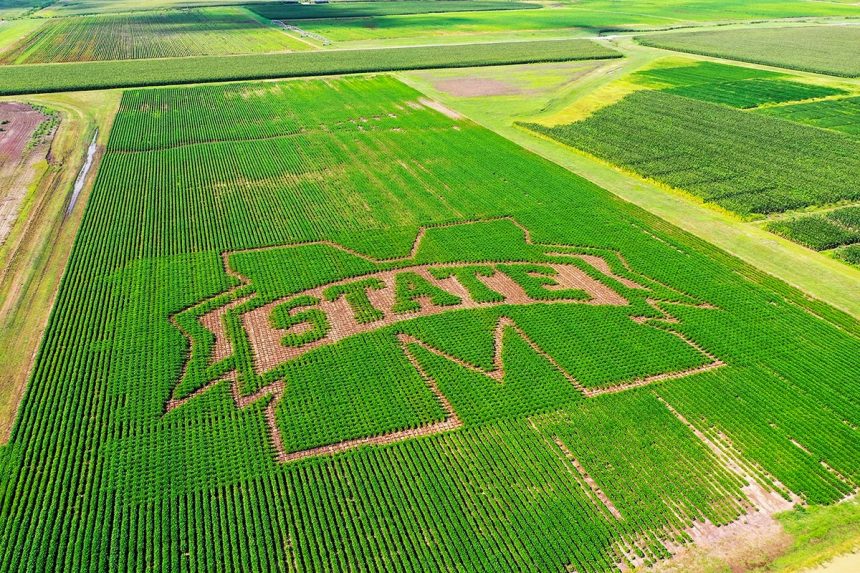Image above: Mississippi State’s iconic M-State spirit mark is showcased at the Mississippi Agricultural and Forestry Experiment Station Black Belt Experiment Station in Brooksville as part of a research project that tests precision planting capabilities. (Photo by David Garraway)
At a site viewable by airplane that is sure to thrill Bulldog fans who have the opportunity to fly over Noxubee County, an iconic Mississippi State spirit mark is being used in a new way by university agriculture researchers.
The M-State logo symbolizes MSU’s position as a top research university, ranking among the top 15 nationally in agricultural sciences year after year, but it’s rare for the spirit mark to play a role in the research itself.
When Dan Reynolds, associate vice president for international programs and former Hartwig Endowed Chair in Soybean Agronomy, tasked his research team with testing the accuracy of a precision planter, the project brought the chance to showcase the classic Mississippi State logo in an unexpected setting. The challenge resulted in twin two-acre fields lush with soybeans which have come to bear the M-State spirit mark at the Black Belt Experiment Station in Brooksville, a unit of the Mississippi Agricultural and Forestry Experiment Station. The precision planter is a tractor equipped with GPS technology used to plant crops.
“As agronomy researchers, we study different plant populations and row spacings across different varieties. With a traditional planter, changing these factors can be quite a challenge. For instance, changing row spacing on a traditional planter means several hours of hard work in the heat,” Reynolds said.
That’s why the team customized the precision planter.
“Our custom research planter is based on precision planting technology. The all-electric planter is driven by GPS and allows us to easily study any row width from 15 or 40 inches through an easy-to-use hydraulic system and change any plant population, switching between two varieties without having to stop and refill the planter,” he said.
Graham Oakley, research associate II, came up with the idea of using the M-State spirit mark to test the planter, and he uploaded a GIS file of the mark to the planter’s software. In one plot, the team planted two varieties of soybeans, each resistant to different herbicides. One variety made up the foreground of the M-State logo, while another made up the background. Once the plant had grown lush and green, the researchers applied herbicide to terminate one of the varieties, which revealed the M-State design. In the other plot, they planted two different varieties of soybeans using the same method.
“When these soybeans mature in the field, one will be a maroon color and the other will be gray. The M-State banner and border will be maroon and everything else will be gray,” Oakley said.
He explained that each M-State, approximately 250 feet long and 350 feet wide, demonstrates the accuracy of the planter and unmanned aerial vehicle technology used to observe plant growth.
“The spirit mark tests the capabilities of the planter when it comes to row narrowness and plant density,” Oakley said. “We planted in a hatched pattern to get a denser image. Each row is 21 squares, which you wouldn’t do in a traditional system. The detail of the M-State shows how you can switch between varieties even within a single row and shows a planting accuracy within a margin of error that’s less than an inch.”
He said the project also showcases the capabilities of the unmanned aerial vehicle, or UAV, the team used to verify the accuracy of the planter and to determine if differences in varieties could be obtained from the aerial view.
“We flew a UAV over both fields and it picks up the differences in the varieties. We can see the red and gray M-State via UAV even though both varieties are still currently green,” Oakley said.
The display surprised a local farmer who happened to fly over the field this summer as the Bulldogs became reigning national champions. The research team, which also includes Beau Varner, research associate III, expects the maroon and gray M-State to mature into its “full glory” around the time of the SEC home opener against LSU at Davis Wade Stadium.
For more on MSU’s Department of Plant and Soil Sciences, visit www.pss.msstate.edu.
For more on the Mississippi Agricultural and Forestry Experiment Station, visit www.mafes.msstate.edu.








